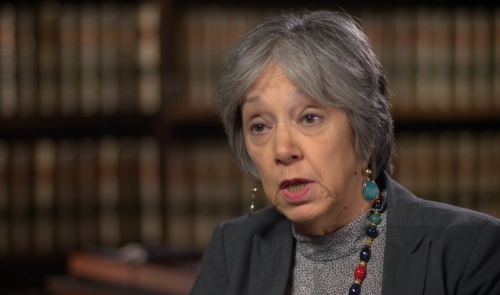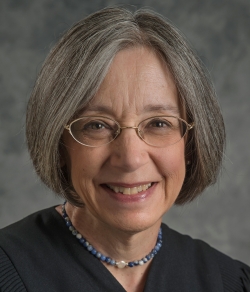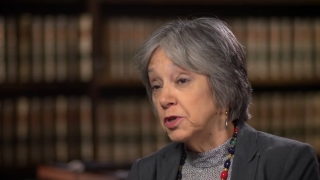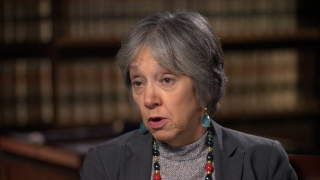Judge Diane P. Wood
Chief Judge, United States Court of Appeals for the Seventh Circuit

Watch the full video or read the transcript (PDF: 559.52 KB).
Biography

Diane P. Wood was appointed to the United States Court of Appeals for the Seventh Circuit by President William J. Clinton on June 30, 1995. She served as chief judge from 2013 to 2020, retiring from the court in 2024. She became Director of the American Law Institute (ALI) in May 2023, succeeding Richard L. Revesz. Judge Wood was born in Plainfield, New Jersey, on July 4, 1950. She lived in Westfield, New Jersey, until the age of sixteen, when she moved to Houston, Texas. She attended the University of Texas for both college and law school, receiving her BA with highest honors and special honors in English in 1971, and her JD with high honors in 1975.
Following her graduation from law school, Judge Wood clerked for Judge Irving Goldberg of the US Court of Appeals for the Fifth Circuit, 1975 term, and for Justice Harry A. Blackmun of the Supreme Court of the United States, 1976 term. After a brief period at the Office of the Legal Adviser of the United States State Department, she was an associate at Covington & Burling from 1978 to 1980, where she had a wide-ranging litigation practice with particular emphasis on antitrust.
From 1980 to 1981, she taught as an assistant professor at the Georgetown University Law Center. In 1981, she was appointed to the University of Chicago Law School faculty, where she served as associate dean from 1989 through 1992. In 1990, she was named the Harold J. and Marion F. Green Chair in International Legal Studies, becoming the first woman at the law school to be honored with a named chair. Immediately prior to joining the court, Judge Wood was deputy assistant attorney general in the Antitrust Division of the US Department of Justice from September 1993 through July 1995, where she was responsible for appellate matters, legal policy, and international enforcement.
Judge Wood’s areas of scholarly interest include antitrust law, international trade and business, and federal civil procedure. She has published widely in all three areas. Representative works include the antitrust casebook Trade Regulation, with Robert Pitofsky and Harvey Goldschmid (4th ed. 1997; 5th ed. 2003; 6th ed. 2010); Merger Cases in the Real World: A Study of Merger Control Procedures (with Richard Whish, OECD 1994) (a study of transnational merger regulation); “‘Unfair’ Trade Injury: A Competition-Based Approach,” 41 Stanford L. Rev. 1153 (1989); and “Our 18th Century Constitution in the 21st Century World,” 80 N.Y.U. L. Rev. 1079 (2005). In addition, she has presented papers for the World Trade Organization in Geneva, Switzerland; for the Organisation for Economic Cooperation and Development in Paris, France; and for many other audiences around the world, including in Australia, Canada, China, France, Italy, Mexico, New Zealand, and South Africa.
Judge Wood has also worked on law reform projects in the United States, particularly through the American Bar Association and the Brookings Institution Project on Civil Justice Reform. She was instrumental in developing the University of Chicago’s first policy on sexual harassment. Judge Wood sits on the council of the American Law Institute. She is also a fellow of the American Academy of Arts and Sciences and chairs its council. For many years, she was also a member of the American Bar Association, where she served on the governing councils of the ABA’s section of antitrust law and its section of international law and practice. Since joining the court, she has continued to teach at the University of Chicago Law School as a senior lecturer.
Her interests include playing the oboe and English horn, which she does actively in several Chicago-area orchestras, travel, and the study of foreign languages and literature. She speaks French well and dabbles in other languages, including Russian and German. She is married to Dr. Robert L. Sufit, and has three children and three step-children.
Video Excerpts
What she learned from clerking for Justice Blackmun
On the role of the court of appeals today
All rights in these oral history interviews belong to New York University. Quoting or excerpting of oral history interviews is permitted as long as the quotation or excerpt is limited to fair use as defined by law. Quotations and excerpts must cite and give proper credit to: IJA Oral History of Distinguished American Judges, Institute of Judicial Administration, NYU School of Law. For quotations or excerpts that exceed fair use, permission must be obtained from the Institute of Judicial Administration. Any permission granted will comply with agreements made with the interviewees and/or interviewers who participated in the oral history project. The transcript shall control over the video for any permitted use.




